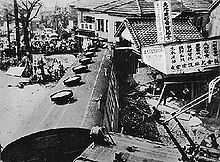Mitaka incident
| Mitaka incident | |
|---|---|
 Derailed train after the incident | |
| Location | Mitaka, Tokyo, Japan |
| Coordinates | 35°42′10″N 139°33′39″E / 35.70278°N 139.56083°ECoordinates: 35°42′10″N 139°33′39″E / 35.70278°N 139.56083°E |
| Date |
July 15, 1949 21:23 (UTC+10) |
| Weapon(s) | Train |
| Deaths | 6 |
| Injured (non-fatal) | 20 |
| Perpetrator | Keisuke Takeuchi |
The Mitaka incident (三鷹事件 Mitaka jiken) was an incident that took place on July 15, 1949, when an unmanned 63 series train with its operating handle tied down drove into Mitaka Station on the Chūō Line in Tokyo, Japan, killing 6 people and injuring 20.
The incident remains shrouded in mystery, as do the Shimoyama and Matsukawa incidents which occurred around the same time, but it is commonly said to have been a plot by the National Railway Workers' Union. The government indicted ten people on a charge of train sabotage resulting in death of the victims, as well as the train's conductor, Keisuke Takeuchi, who was not in the train when it derailed.
On the day of the derailment, all four of the police officers at Mitaka Station abandoned their posts; this was never explained. Two of the alleged conspirators were indicted for perjury. Takeuchi's lawyer refused to allow a coworker to present evidence affirming that he and Takeuchi were in a public bath together when the train left the station (an apparently airtight proof that at least one other person was involved), claiming it was "irrelevant to the case".
In a court ruling in 1955, the judge found there was no evidence of a conspiracy, but rather that Takeuchi had planned and executed the entire incident himself. Takeuchi was sentenced to death; the other defendants were declared innocent of all charges. All appeals of the verdict were rejected.
All the acquitted defendants were members of the Japan Communist Party, but Takeuchi was not. Takeuchi died in jail in 1967 of a brain tumour. Until his death, he continued to proclaim his innocence, an unusual occurrence in the Japanese legal system.
The Shimoyama incident, which came to light on July 5, 1949, the Matsukawa derailment, which occurred on August 17, 1949, and the Mitaka incident together make up the three great mysteries of Japanese National Railways.
External links
- 日本労働年鑑 第24集 1952年版掲載の弁護側主張 (Japanese)
- 最高裁判例 (Japanese)
| ||||||||